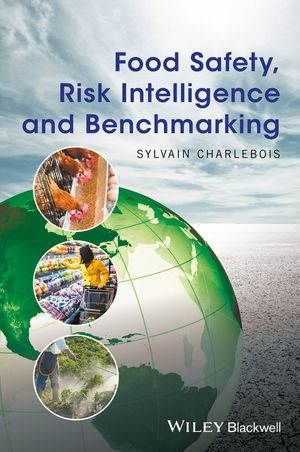CFSAN’s Risk Management Framework: Best Practices for Resolving Complex Food Safety Risks

”However good our future’s research may be, we shall never be able to escape from the ultimate dilemma that all our knowledge is about the past, and all our decisions are about the future.”
The above quote, attributed to Ian Wilson#, describes the challenge food safety risk managers must wrestle with each day—decisions must be made in the face of uncertainty.[1] Risk management is defined as the process of weighing policy alternatives and implementing appropriate control options. Leaders at the Food and Drug Administration’s (FDA) Center for Food Safety and Applied Nutrition (CFSAN) recognized that the principles of risk management were embedded within the Center’s mission, decision-making process, scientific knowledge, legal authorities and culture. However, CFSAN lacked a formal framework to ensure that these principles were applied uniformly and consistently throughout the Center.
To achieve this desired result, CFSAN assembled a working group in October 2002 and charged it with developing a stepwise risk management framework. The working group sought to combine the general principles of risk management with the best practices CFSAN has traditionally used to grapple with complex food safety, nutrition and cosmetics safety issues. This article describes the framework the working group devised and explains how the Center identifies, prioritizes, and executes projects, as well as the need to monitor and evaluate the outcomes of its decisions.
Understanding the Framework
 The risk management framework CFSAN developed has seven distinct but interrelated components: triggers and inputs, prioritization, process (internal and external), decision, implementation, outcome, and monitor/evaluate/modify. A diagram of the framework is shown in Figure 1. The framework is iterative in nature and the arrows in the diagram indicate that information can and should flow in multiple directions. The monitor/evaluate/modify step is shown in a different color to emphasize its importance. This step is essential because it serves as a feedback mechanism enabling CFSAN to measure the effectiveness of its public health strategies.
The risk management framework CFSAN developed has seven distinct but interrelated components: triggers and inputs, prioritization, process (internal and external), decision, implementation, outcome, and monitor/evaluate/modify. A diagram of the framework is shown in Figure 1. The framework is iterative in nature and the arrows in the diagram indicate that information can and should flow in multiple directions. The monitor/evaluate/modify step is shown in a different color to emphasize its importance. This step is essential because it serves as a feedback mechanism enabling CFSAN to measure the effectiveness of its public health strategies.
Triggers and Inputs. An input is an indicator of risk related to foods, cosmetics, or other areas for which CFSAN has regulatory authority. If a single input or summation of multiple inputs indicate the emergence or possible emergence of a risk that cannot be managed by CFSAN’s current risk management practices, the need for a new practice is triggered. When this occurs, CFSAN managers implement the risk management framework. Triggers come from a variety of sources but generally result from one of four events or a combination thereof: a crisis, new scientific evidence or technological advances, an emerging risk, or implementation of a strategic plan.
A crisis trigger is a sudden or severe event and can be the result of real or perceived risk. Examples of crisis triggers include an outbreak of illness from a new foodborne pathogen and food contamination caused by a hurricane. Perceived risks could include public concern about the health impact of a previously undetected, naturally occurring substance in the food supply.
New scientific evidence or technological advances that uncover public health hazards or concerns also could act as a trigger. Examples include detection of some previously undetected toxicant in an FDA-regulated product due to improved or more sensitive surveillance methods.
Emerging triggers or “on the horizon” triggers are potential risks which are identified by well-planned forecasting techniques before they become a pronounced public health concern. Identifying emerging triggers may involve taking into account events in parts of the world from which the U.S. imports food or cosmetic products and assessing the potential impact of such situations on the U.S. population.
Other triggers for utilizing the risk management framework are the result of internally generated efforts, such as implementation of a strategic plan. Each year CFSAN identifies Program Priorities which are intended to improve the public health.[2] In the course of executing these priorities risk management decisions are often required.
Prioritization. During the prioritization step of the framework, CFSAN weighs the public health importance of the new input relative to the Center’s capacity to address the risk, taking into consideration other ongoing public health efforts, as well as the timeframe necessary to take action. In this step risk managers attempt to frame the public health issue. Is it narrow and applicable only to very specific circumstances or is it broader in scope? A narrow issue would include mitigating the impact from a product-specific foodborne illness outbreak. A broader issue might include assessing toxicity of a chemical relative to those that are already approved for use as food additives. Putting the issue into context also includes considering whether or not CFSAN actions would affect or be affected by existing international agreements.
Process. In the process step, CFSAN gathers and communicates information and data both internally and externally. It is essential that the roles and responsibilities of risk managers are established during this step. If necessary, the decision-maker will form and direct teams to gather the information necessary to make a successful decision. The teams may evaluate industry and consumer interests, public confidence in the food supply, congressional and political interests, and integrate information gathered internally and externally.
The internal process may include gathering information from staff records and conducting literature searches, risk assessments, or cost-benefit analyses. Scientific justification is the critical factor by which the credibility of risk management decisions is judged and in some cases new research may be required.
A critical component in the internal process is building consensus within the Center about the science and other influencing factors (i.e. policy, legal authority, societal values, etc.) that affect CFSAN’s potential course of action. This may contribute to a deliberate and slow risk management process. Risk managers must consider ways to expedite consensus building and avoid rate-limiting steps in the risk management process, whenever possible.
The external process is a means to provide information to and gather data from outside experts and interested parties. CFSAN may leverage partnerships with stakeholders, including those in industry, trade associations, state and federal agencies, foreign governments, academia, consumer advocacy groups, and others. The external process should be both transparent and open.
Transparency involves sharing publicly what CFSAN knows. It includes providing a venue for the public to access and review all non-proprietary data, either through the CFSAN website, in public dockets, in the Federal Register, or at public meetings. Being open means sharing publicly what CFSAN is doing to address the risk management issue. This includes identifying CFSAN’s general approach and seeking input from consumer advocates, advisory committees, industry, trade associations, scientific experts, health care professionals, international standard-setting bodies, other federal agencies, foreign governments, and others.
The internal and external process timeframes overlap and, like the overall framework, are dynamic and iterative. Feedback between the two processes is necessary to address the risk comprehensively. Information gleaned during the process step may result in changes to the assessment prioritization of the public health risk being addressed.
Decision. In the decision step CFSAN determines what action will be taken to address the identified risk. There can be a single decision, multiple decisions, or phased-in (tiered) decisions. Ultimately, the decisions of risk managers are judgments reached by weighing the facts, evidence, information, and historical precedents. Decisions may also be driven by the availability of resources, the need to address an immediate public concern, and the knowledge base. In some instances CFSAN may need to move quickly even though some science may not be available.
The Center may decide to address a risk by publishing a regulation; issuing guidance or a consumer advisory; conducting training, outreach, or education; asking industry to consider a recall; taking enforcement action; banning a substance; requiring informational or warning labels; setting a mortality goal or performance standard; requiring industry testing; establishing an action plan; doing nothing (active decision); or some other means. Ideally, the decision should be modifiable in the event that feedback shows that the decision can be improved upon. Likewise, in the course of making a decision it may become evident that some aspects of the process step need to be revisited.
Implementation. The goal of this step is to act on the decisions made in the previous stage, within the limits of the available resources. It also includes identifying and mobilizing program resources, including staff time and expertise, filling training needs, and establishing procedures to be applied by FDA field and Center staff. A contingency plan should be developed so that adjustments can be made to the decision or the implementation efforts if feedback indicates that mid-course changes are needed to reach the desired outcome.
Outcome. The outcome is the impact of the risk management efforts on the public health. Questions to be asked and answered in this step include: What was the outcome? How is success defined? How is success measured?
Monitor/Evaluate/Modify. The purpose of this step is to continually measure and evaluate the outcome so CFSAN can determine whether the risk management prioritizations, decisions, processes, or implementation efforts need to be modified in light of the risk reduction that has been achieved or due to other new information. Questions CFSAN asks and answers in this phase include: What is the plan to follow up, monitor and re-evaluate? Was the plan followed? What lessons can be learned and applied to future situations?
 Impact on CFSAN
Impact on CFSAN
A comprehensive training program was developed and implemented to inform and educate staff about the risk management framework. The training program has successfully raised awareness within CFSAN not only about the framework itself but also about related concepts, such as risk and uncertainty, and how these affect decisions. It has prompted requests for additional training and information on risk assessment, expert elicitation and decision analysis.
The risk management framework has reinforced how and what our diverse staff contributes to the decision-making process. It clarifies the role of CFSAN’s laboratory scientists in generating and evaluating data as well as information attained during the internal process step. It also elucidates how social scientists can assist with implementing decisions by conducting focus group testing to help hone public health messages. Through experimentation CFSAN has learned that omitting a stage of the framework actually slows progress toward devising effective risk mitigation strategies, thus reinforcing the importance of adhering to the framework’s components.
Recognizing the importance of institutionalizing the risk management framework, CFSAN’s director has assigned specific staff with the responsibility for managing the risk management framework, implementing the approach within the Center, and updating the training materials, as necessary.
Conclusion
CFSAN’s Risk Management Framework is designed to be a formal, yet simple process by which risk can be managed and the public health protected. It is flexible and comprehensive enough to handle food and cosmetic safety emergencies as well as to serve as a tool in developing public health policies with long-term goals. A combination of the framework’s iterative nature, its openness and transparency, and its built-in feedback mechanisms help ensure that CFSAN’s risk management decisions are based on the most current information available.
Sherri Dennis, Ph.D., is the Risk Analysis Coordinator in CFSAN’s Office of Science and a member of CFSAN’s risk management workgroup.
Lou Carson is Deputy Director of CFSAN’s Office of Food Safety, Defense, and Outreach and a member of CFSAN’s risk management workgroup.
Supratim Choudhuri, Ph.D., is a toxicologist in CFSAN’s Office of Food Additive Safety and a member of CFSAN’s risk management workgroup.
Pat Klein, V.M.D., is a veterinarian and was a member of CFSAN’s Office of Plant and Dairy Foods, as well as CFSAN’s risk management working group. She currently works for USDA’s Office of Animal and Plant Health Inspection Service.
Series Editor Sebastian Cianci is a policy analyst and a member of CFSAN’s Office of Food Safety, Defense, and Outreach.
References
1. Ian H. Wilson of Wolf Enterprises in San Rafael, California, is a scenario planning expert and strategy consultant.
2. FY2005 Program Priorities. www.cfsan.fda.gov/~dms/cfsand04.html.
Looking for a reprint of this article?
From high-res PDFs to custom plaques, order your copy today!






.webp?t=1721343192)
